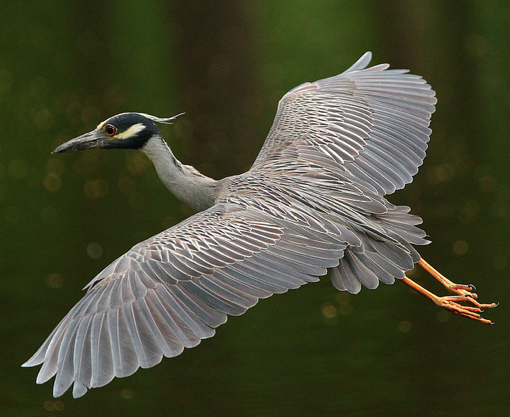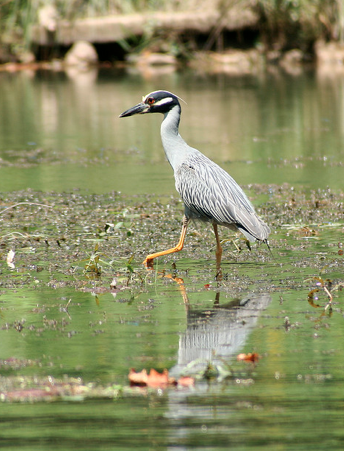Form and Function
 There are 12 species of herons found in North America; the
yellow-crowned night heron differs from other species by its
nocturnal activity as well as its yellowish crown stripe
(Kushlan 1976; Cornel
2009). They have medium sized bodies, with both sexes weighing
in at
around 22.9-28.2 oz and 21.7-27.6 inches tall (Cornel 2009). Both
male and female look alike, having a white crown, red eyes and a
white stripe below their eye. The adult body is entirely slate
grey, and juvenile is a mix of brown and grey. They are well
camouflaged in their grey/brown coloring and are very secretive
birds, as well as nest in small scattered colonies in forested
habitats (Watts 1995).
There are 12 species of herons found in North America; the
yellow-crowned night heron differs from other species by its
nocturnal activity as well as its yellowish crown stripe
(Kushlan 1976; Cornel
2009). They have medium sized bodies, with both sexes weighing
in at
around 22.9-28.2 oz and 21.7-27.6 inches tall (Cornel 2009). Both
male and female look alike, having a white crown, red eyes and a
white stripe below their eye. The adult body is entirely slate
grey, and juvenile is a mix of brown and grey. They are well
camouflaged in their grey/brown coloring and are very secretive
birds, as well as nest in small scattered colonies in forested
habitats (Watts 1995).
Like all herons, the yellow-crowned
night-heron is a wading bird with tall stocky legs and a long
slender beak. These adaptations facilitate feeding using two techniques: the stand and wait technique and the
walk slowly technique (Meyerricks 1960).
 In addition to wading and
walking along the coast, they are also flying birds. In flight,
they keep an S shape in their neck and fly with feet and legs
apart. Though yellow-crowned herons are shy, they have a
loud call that can separate them from other birds. Their call includes a harsh squawk, which is higher pitched than that of the
black-crowned night heron (Sutherland and Gunn 2010; Elliot
et al. 2004). The call is often emitted when the bird is
disturbed (Elliot et al. 2004). You can listen to a
yellow-crowned night heron call
here.
In addition to wading and
walking along the coast, they are also flying birds. In flight,
they keep an S shape in their neck and fly with feet and legs
apart. Though yellow-crowned herons are shy, they have a
loud call that can separate them from other birds. Their call includes a harsh squawk, which is higher pitched than that of the
black-crowned night heron (Sutherland and Gunn 2010; Elliot
et al. 2004). The call is often emitted when the bird is
disturbed (Elliot et al. 2004). You can listen to a
yellow-crowned night heron call
here.
This organism possesses a feathered coat that allows for a
seasonal molting to occur. Like most herons, their pre-formative
molt occurs mid September to late February and the second
pre-basic molt occurs between late April and late June, after
which they are classified as adults. Once a yellow-crowned night
heron reaches adulthood, no contour feather molting occurs. They
exhibit a complex basic strategy of molting (Pyle and Howell
2004; Howell et al. 2003). These characteristics develop
throughout the life
cycle and assist in
reproduction as described on the next page.